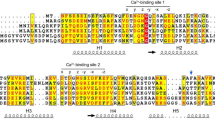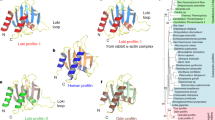Summary
We have isolated and purified an activity from amoebae ofPhysarum polycephalum that reduces the flow birefringence of a solution of F-actin in a Ca2+-dependent manner. The purified activity from 100 g of amoebae consisted of 1 mg of a 40000 mol. wt protein. DNase I-affinity chromatography demonstrated that the protein binds toPhysarum actin in a Ca2+-dependent manner, and the binding is not reversed by excess EGTA. Viscometric measurement indicated that the protein (i) accelerates polymerization of G-actin, and (ii) severs F-actin, in a Ca2+-dependent manner. Thus, the protein appeared functionally similar to the fragmin previously isolated fromPhysarum plasmodia (plasmodial fragmin). However, the two proteins had slightly different mobilities on urea-SDS-PAGE, and antibodies raised against the two proteins scarcely cross-reacted with each other. Hence, we conclude that the two proteins are closely related to but are different from each other, and we have named the novel protein ‘myxamoebal fragmin’. Immunoblot analysis indicated that myxamoebal and plasmodial fragmins are specifically present in amoebae and plasmodia, respectively. Results of immunofluorescence staining suggest that the synthesis of plasmodial fragmin is switched on coordinately with the synthesis of the heavy chain of plasmodial myosin and other plasmodium-specific contractile proteins during the apogamic differentiation of amoebae to plasmodia.
Similar content being viewed by others
References
Alexopoulos, C. J. (1982) Morphology, taxonomy, and phylogeny. InCell Biology of Physarumand Didymium (edited byAldrich, H. C. &Daniel, J. W.), Vol. 1, pp. 3–23. New York: Academic Press.
Anderson, R. W., Cooke, D. J. &Dee, J. (1976) Apogamic development of plasmodia in the myxomycetePhysarum polycephalum: a cinematographic analysis.Protoplasma 89, 29–40.
Bradford, M. M. (1976) A rapid and sensitive method for the quantitation of microgram quantities of protein utilizing the principle of protein-dye binding.Anal. Biochem. 72, 248–54.
Burkett, C. R., Foster, K. E., Johnson, J. &Gull, K. (1985) Use of monoclonal antibodies to analyze the expression of a multi-tubulin family.FEBS Lett.187, 211–8.
Burland, T. &Dee, J. (1979) Temperature-sensitive mutants ofPhysarum polycephalum — expression of mutations in amoebae and plasmodia.Genet. Res. 34, 33–40.
Burland, T. G., Gull, K., Schedl, T., Boston, R. S. &Dove, W. F. (1983) Cell type-dependent expression of rubulins inPhysarum.J. Cell Biol. 97, 1852–9.
Clarke, M. &Spudich, J. A. (1977) Nonmuscle contractile proteins: The role of actin and myosin in cell motility and shape determination.Ann. Rev. Biochem. 46, 797–822.
Cooke, D. J. &Dee, J. (1974) Plasmodium formation without change in nuclear DNA content inPhysarum polycephalum.Genet. Res. 23, 307–317.
Hasegawa, T., Takahashi, S., Hayashi, H. &Hatano, S. (1980) Fragmin: a calcium ion sensitive regulatory factor on the formation of actin filaments.Biochemistry 19, 2677–83.
Hatano, S. &Owaribe, K. (1976) Actin and actinin from myxomycete plasmodia. InCell Motility (edited byGoldman, R., Pollard, T. &Rosenbaum, J.), Vol. 3, Book B, pp. 499–511. New York: Cold Spring Harbor Laboratory.
Hatano, S. &Owaribe, K. (1977) A simple method for the isolation of actin from myxomycete plasmodia.J. Biochem. 82, 201–5.
Hinssen, H. (1981a) An actin-modulating protein from Physarum polycephalum. I. Isolation and purification.Eur. J. Cell Biol. 23, 225–33.
Hinssen, H. (1981b) An actin-modulating protein from Physarum polycephalum. II. Ca++-dependence and other properties.Eur. J. Cell Biol. 23, 234–40.
Hosoya, H. &Mabuchi, I. (1984) A 45,000-mol-wt protein-actin complex from unfertilized sea urchin egg affects assembly properties of actin.J. Cell Biol. 99, 994–1001.
Ishigami, M., Kuroda, K. &Hatano, S. (1987) Dynamic aspects of the contractile system inPhysarum plasmodium. III. Cyclic contraction-relaxation of the plasmodial fragment in accordance with the generation-degeneration of cytoplasmic actomyosin fibrils.J. Cell Biol. 105, 381–6.
Kohama, K., Takano-Ohmuro, H., Tanaka, T., Yamaguchi, Y. &Kohama, T. (1986) Isolation and characterization of myosin from amoebae ofPhysarum polycephalum.J. Biol. Chem. 261, 8022–7.
Kondo, H. &Ishiwata, S. (1976) Uni-directional growth of F-actin.J. Biochem. 79, 159–71.
Korn, E. D. (1982) Actin polymerization and its regulation by proteins from nonmuscle cells.Physiol. Rev. 62, 672–737.
Kwiatkowski, D. J., Stossel, T. P., Orkin, S. H., Mole, J. E., Colten, H. R. &Yin, H. L. (1986) Plasma and cytoplasmic gelsolins are encoded by a single gene and contain a duplicated actin-binding domain.Nature 323, 455–8.
Laemmli, U. K. (1970) Cleavage of structural proteins during the assembly of the head of bacteriophage T4.Nature 227, 680–5.
Larue, H., Masson, S., Lafontaine, J. G., Nadeau, P. &Pallotta, D. (1982) Changes in protein and RNA during asexual differentiation ofPhysarum polycephalum. Can. J. Microbiol.28, 438–47.
Lazarides, E. &Lindberg, U. (1974) Actin is the naturally occurring inhibitor of deoxyribonuclease I.Proc. Natl Acad. Sci. USA. 71, 4742–6.
Mabuchi, I. (1985) Actin regulatory proteins: Echinodermata eggs. InStructure and Function of Cytaskeleton (edited byThe Japanese Biochemical Society), pp. 301–18. Tokyo: Tokyo Kagaku Dojin (in Japanese).
Nagata, K. &Ichikawa, Y. (1985) Changes in actin during cell differentiation. InCell and Muscle Motility (edited byShaw, J. W.), Vol. 5, pp. 171–94. New York: Plenum Publishing.
Portzehl, H., Caldwell, P. C. &Ruegg, J. C. (1964) The dependence of contraction and relaxation of muscle fibres from the crabMaia squinado on the internal concentration of free calcium ions.Biochim. Biophys. Acta 79, 581–91.
Schroeder, T. E. (1975) Dynamics of the contractile ring. InMolecules and Cell Movement (edited byInoué, S. &Stephens, R. E.), pp. 305–34. New York: Raven Press.
Sutoh, K., Iwane, M., Matsuzaki, F., Kikuchi, M. &Ikai, A. (1984) Isolation and characterization of a high molecular weight actin-binding protein fromPhysarum polycephalum plasmodia.J. Cell Biol. 98, 1611–8.
Taylor, D. L. &Condeelis, J. S. (1979) Cytoplasmic structure and contractility in amoeboid cells.Int. Rev. Cytol. 56, 57–144.
Towbin, H., Staehelin, T. &Gordon, J. (1979) Electrophoretic transfer of proteins from polyacrylamide gels to nitrocellulose sheets: procedure and some applications.Proc. Natl Acad. Sci. USA. 76, 4350–4.
Turnock, G., Morris, S. R. &Dee, J. (1981) A comparison of the proteins of the amoebal and plasmodial phases of the slime mold,Physarum polycephalum.Eur. J. Biochem. 115, 533–8.
Uyeda, T. Q. P. &Furuya, M. (1984) Cycloheximide insensitive amoebo-flagellate transformation in starved amoebae ofPhysarum polycephalum.Develop. Growth Differ. 26, 121–8.
Uyeda, T. Q. P. &Furuya, M. (1985) Cytoskeletal changes visualized by fluorescence microscopy during amoeba-to-flagellate and flagellate-to-amoeba transformations inPhysarum polycephalum.Protoplasma 126, 221–32.
Uyeda, T. Q. P. &Furuya, M. (1986) Effects of low temperature and calcium on microfilament structures in flagellates ofPhysarum polycephalum.Exp. Cell Res. 165, 461–72.
Uyeda, T. Q. P. &Kohama, K. (1987) Myosin switching during amoebo-plasmodial differentiation of slime mold,Physarum polycephalum.Exp. Cell Res. 169, 74–84.
Wakasugi, M. &Ohta, J. (1973) Studies on the amoebo-flagellate transformation inPhysarum polycephalum.Bot. Mag. Tokyo 86, 299–308.
Wheals, A. E. (1970) A homothallic strain of the myxomycetePhysarum polycephalum.Genetics 66, 623–33.
Yamamoto, K., Pardee, J. D., Reidler, J., Stryer, L. &Spudich, J. A. (1982) Mechanism of interaction ofDictyostelium severin with actin filaments.J. Cell Biol. 95, 711–9.
Yin, H. L., Kwiatkowski, D. J., Mole, J. E. &Cole, F. S. (1984) Structure and biosynthesis of cytoplasmic and secreted variants of gelsolin.J. biol. Chem. 259, 5271–6.
Yumura, S., Mori, H. &Fukui, Y. (1984) Localization of actin and myosin for the study of ameboid movement inDictyostelium using improved immunofluorescence.J. Cell Biol. 99, 894–9.
Yumura, S. &Fukui, Y. (1985) Reversible cyclic AMP-dependent change in distribution of myosin thick filaments inDictyostelium.Nature 314, 194–6.
Author information
Authors and Affiliations
Rights and permissions
About this article
Cite this article
Uyeda, T.Q.P., Hatano, S., Kohama, K. et al. Purification of myxamoebal fragmin, and switching of myxamoebal fragmin to plasmodial fragmin during differentiation ofPhysarum polycephalum . J Muscle Res Cell Motil 9, 233–240 (1988). https://doi.org/10.1007/BF01773893
Received:
Issue Date:
DOI: https://doi.org/10.1007/BF01773893




